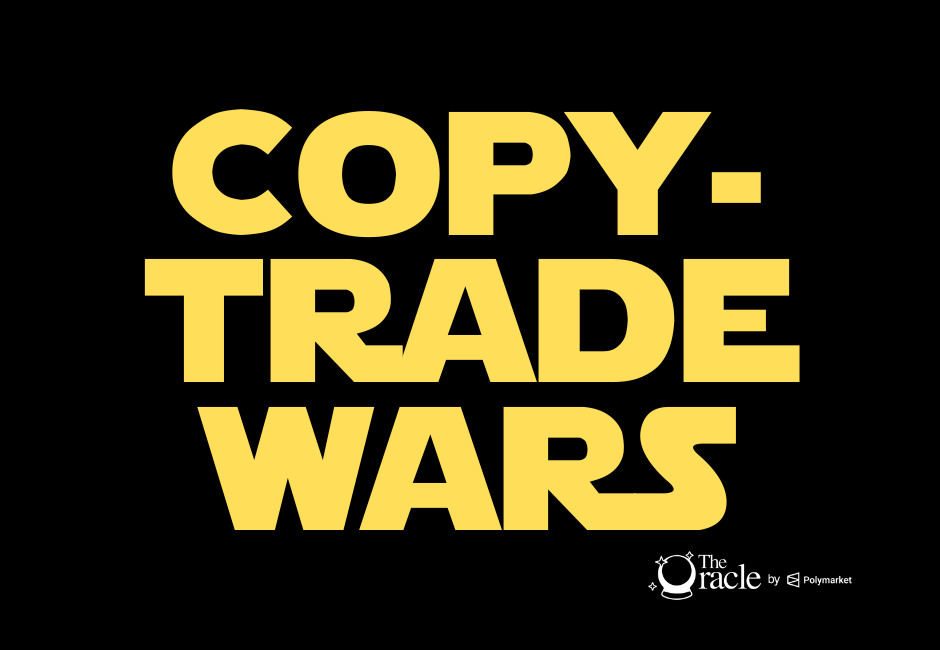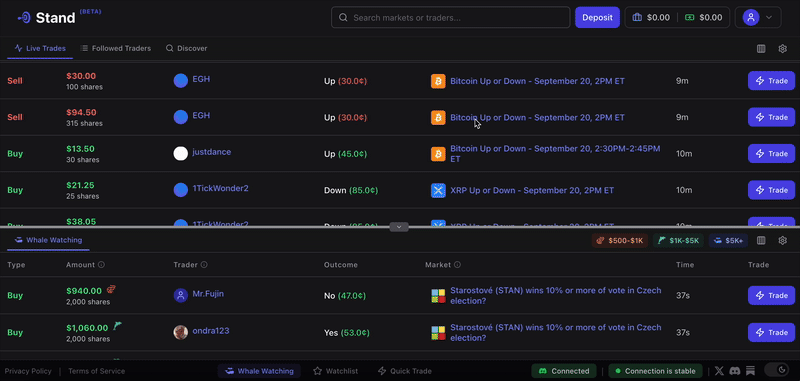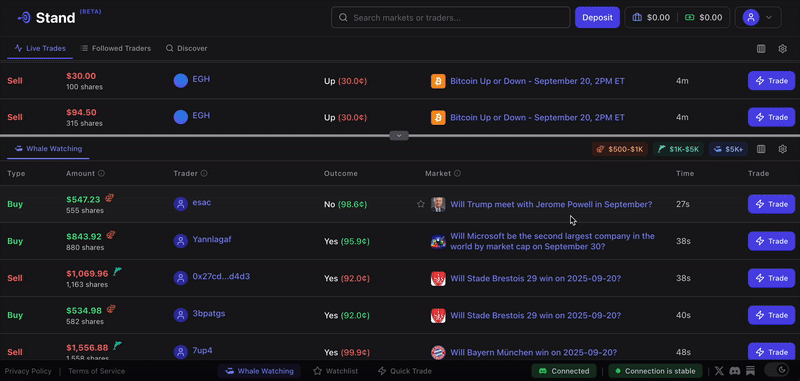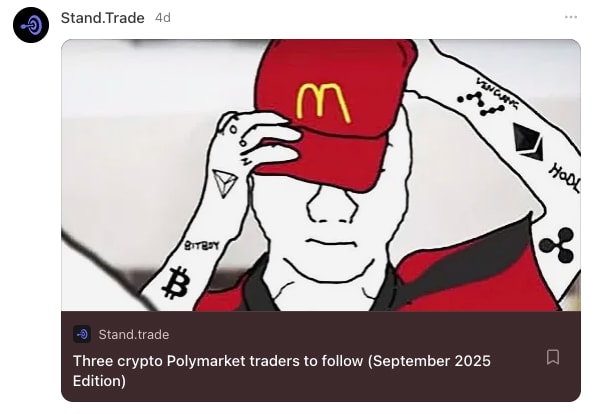🔮 COPYTRADE WARS
Inside the hunt for Polymarket’s most elusive whales
On Polymarket, all trades are visible publicly.
This impacts trading dynamics: some whales love the clout. Others see it as an “edge leak” that dilutes their ability to accumulate shares at a good price. This has evolved into a cat and mouse game, with some of Polymarket’s sharpest traders covering their tracks by using multiple wallets, swapping handles, and taking other steps to throw copycats off their scent.
Stand.trade is the latest tool in this war. It’s an advanced trading terminal and Discord bot that allows users to find and keep tabs on their favorite accounts. The Oracle spoke with Stand founder Ridgely about what he’s learned from building software for some of Polymarket’s top traders.
This interview has been edited for length. All answers are his own.
What have you learned about the different subcultures of Polymarket traders in your research?
We started by building a prediction market perps [leverage trading] product that didn't gain traction. But this led me to spend more time actually talking to traders. Through those conversations, I discovered they desperately wanted Discord alerts when whales made trades. There are so many subcultures of traders: weather traders, mention market specialists, political traders. Understanding these communities led us to build Stand Bot (Discord link) first.
Then traders kept asking for more advanced terminal features. They wanted live trade feeds, the ability to follow specific traders, and filtering by P&L. They complained about Polymarket's UI lacking functionality from other trading platforms.
There tend to be two types of traders: people who want to be right and people who want to make money. The "want to be right" ones tend to be political junkies or domain experts. The money-focused traders typically come from perp, high-frequency, or financial backgrounds.
What information do users get on Stand that they can’t get from the regular Polymarket interface?
There are a few things. First, Polymarket lets you see the trades of user accounts, but there’s no way to follow them on an ongoing basis and get alerts when they make a move. Stand automates that.
Stand also lets you see more easily the exact price the person bought their shares at, which could be much different than the current market price of the contract.
Finally, we give insight into why a trader might hold a position. There are two general reasons why a trader may be in a position: to earn liquidity rewards, or to make a directional (Yes / No) bet.
Stand shows when traders have offsetting Yes / No positions. This helps other traders understand if there's actual conviction or if someone is just farming liquidity rewards.
How is the ‘whale watching’ game changing over time?
We have a "whale watching" feed showing large trades bracketed by size: shrimp, dolphins, and whales. Traders use this for discovery to spot new strategies.
One user told us they make over $10k per month on our platform. They watch for multiple big traders they follow all moving in the same direction on a market, then jump in. When you see that real-time action, it gives you the ability to quickly react. Prediction markets rely on speed and efficiency.
We've gotten into this cat-and-mouse game. Top traders now have secondary and tertiary accounts because they know their main accounts are being copy traded immediately.
In tariff markets, for example, when the US-China agreement news broke, we saw some unrecognized wallet addresses make major buys on the whale feed before the well known traders, usually a few seconds from one another, so smart users can deduce a connection. They know they can be very price sensitive when everyone's watching.
We see accounts that mirror behavioral patterns of known successful traders. Dormant accounts suddenly dropping six figures in markets where famous traders historically operated. The age of accounts matters greatly. The whale watching view can provide some clues as to who’s doing what.
Maybe the whales are getting too tricky so it’s easier to just reverse the biggest losers?
Absolutely. We hear about people counter-trading accounts with negative P&L historically. They want to punish the big losers and do the exact opposite. That's a very common strategy.
What else are you learning from the best traders?
There’s a lot of advice about how traders should stay in their lane. Like, I've never seen Domer go into a sports market. But there are also some accounts that have huge variance by category. Someone might have a six or seven-figure P&L in political markets but negative six figures in sports. The filtering by category is crucial.
There's S Works who's really good in NBA markets but not great at MLB. You see these specialization patterns everywhere.
It’s also interesting to see the insane lengths some people will go on research. For NBA MVP, one trader had a spreadsheet of the 100 voters, tracking any mention or declared vote. When it was clear SGA would win last year, they put everything into it while it was still under 50%.
Another trader does the same with Rotten Tomatoes scores, keeping spreadsheets of all publications and reviews to predict fresh ratings before they're finalized.
Who are your favorite traders to watch?
GreekGamblerPM exclusively focuses on mention markets and uses our product faithfully. Ben Wyatt is a big MLB trader, top 100 in sports, now moving into NFL. A lot of people might just click on his Polymarket profile, see a negative total P&L and click away. But under the hood you can see he’s crushing MLB but not other areas. A lot of sports traders on our platform collectively follow him.
We also have a Substack where we profile interesting trades and traders that we come across in our research:
Are prediction market skills transferable to traditional markets?
We're seeing top forecasters from Metaculus and Polymarket getting recruited by institutions. They can see the track record and it's easier to just give them a bankroll and say "go nuts."
75-80% of our users have financial backgrounds and regularly trade stocks or options. For them, prediction markets are entertainment, taking those skills laterally to this evolving space.
Someone showed they used prediction markets for Tesla forecasts, then bought stock options around that and substantially outperformed the market. They could see what prediction markets thought Tesla's output would be before the next earnings call.
What's coming next?
We're building out more automation within the platform. Complex mechanisms beyond simple clicks - more advanced maneuvers you'd see in mature financial markets.
We're also improving our filtering so traders can better sort by negative P&L to find accounts to fade. That's one of our most requested features.
As we’re seeing with the copytrade meta, markets inherently get more efficient and adapt quickly. Old strategies from when spreads were wide or rules were ambiguous don't apply anymore. With more capital and players entering, you have to know your market category and understand that strategies evolve.
The brilliance of prediction markets is in that adaptation mechanism. But it also means you need to stay ahead of the game.
Disclaimer: Nothing in The Oracle is financial, investment, legal or any other type of professional advice. Anything provided is for informational purposes only and is not meant to be an endorsement of any activity or market. Terms of Service on polymarket.com prohibit US persons and certain other jurisdictions from using Polymarket to trade, although data and information is viewable globally.







gamers rise up
awesome discussion